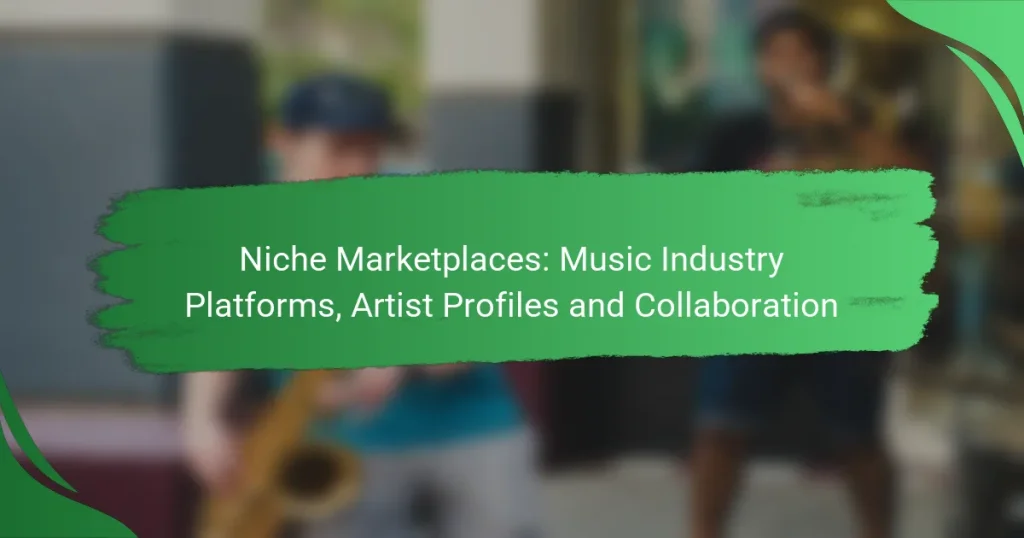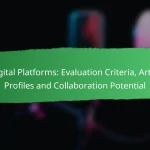Niche marketplaces in the music industry provide essential platforms for artists, producers, and collaborators to connect and thrive. With options like SoundBetter, Bandcamp, and ReverbNation, these platforms cater to diverse needs, allowing artists to showcase their profiles and engage with audiences effectively. Additionally, they facilitate collaboration opportunities, enabling users to network and share resources for successful musical projects.
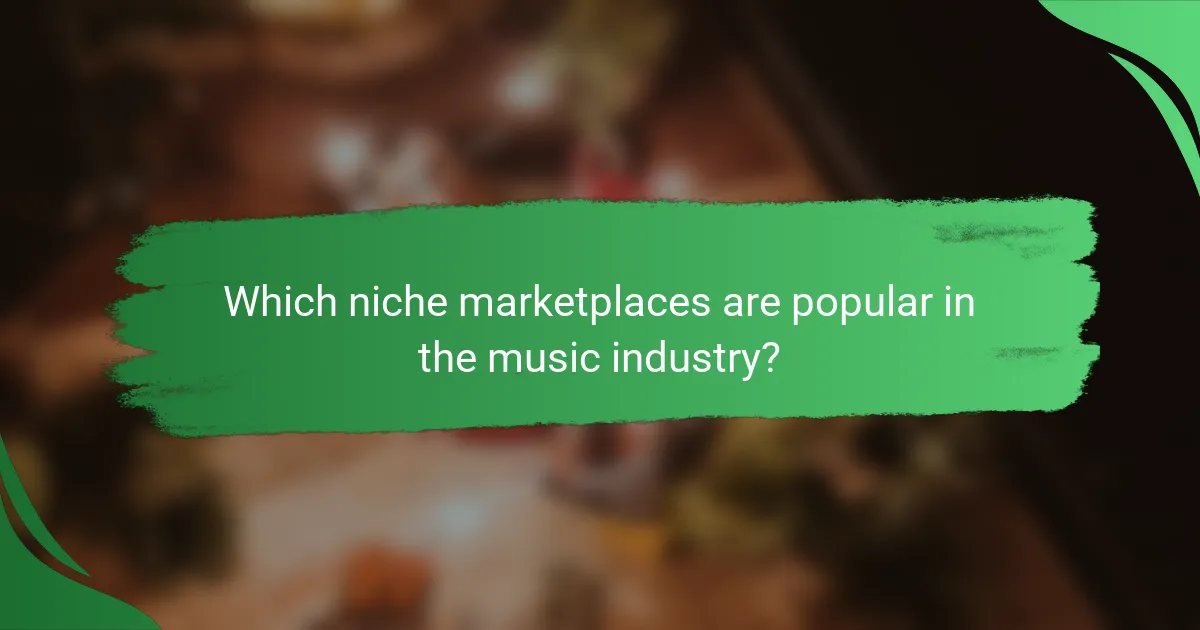
Which niche marketplaces are popular in the music industry?
Several niche marketplaces cater specifically to the music industry, allowing artists, producers, and collaborators to connect. Popular platforms include SoundBetter, Bandcamp, ReverbNation, Fiverr, and AirGigs, each offering unique features tailored to different needs within the music ecosystem.
SoundBetter
SoundBetter is a platform designed for musicians to find and hire professionals for various music-related services, such as mixing, mastering, and songwriting. Artists can browse profiles, listen to samples, and read reviews to make informed choices.
When using SoundBetter, consider the pricing, which can range from affordable to premium based on the professional’s experience. It’s crucial to communicate your project needs clearly to ensure a successful collaboration.
Bandcamp
Bandcamp allows artists to sell their music directly to fans, offering a platform for independent musicians to showcase their work. Artists can set their own prices and retain a significant portion of the revenue, making it a favorable option for emerging talent.
Utilizing Bandcamp effectively involves promoting your page through social media and engaging with your audience. Consider offering exclusive content or merchandise to incentivize purchases and build a loyal fanbase.
ReverbNation
ReverbNation provides tools for artists to manage their careers, including distribution, promotion, and fan engagement features. It serves as a hub for musicians to connect with industry professionals and gain exposure through curated opportunities.
To maximize your presence on ReverbNation, regularly update your profile with new music and engage with the community. Take advantage of the platform’s analytics to understand your audience better and tailor your marketing strategies accordingly.
Fiverr
Fiverr is a freelance marketplace where musicians can offer and purchase a wide range of services, from graphic design to music production. It allows artists to find affordable options for specific tasks, making it accessible for those on a budget.
When using Fiverr, carefully review seller ratings and portfolios to ensure quality. Set clear expectations and deadlines to avoid misunderstandings and ensure timely delivery of services.
AirGigs
AirGigs specializes in connecting musicians with session players and vocalists for remote collaborations. This platform is ideal for artists looking to enhance their tracks with professional performances without geographical limitations.
To get the most out of AirGigs, provide detailed project descriptions and reference tracks to guide collaborators. Be open to feedback and revisions to achieve the best results for your music project.
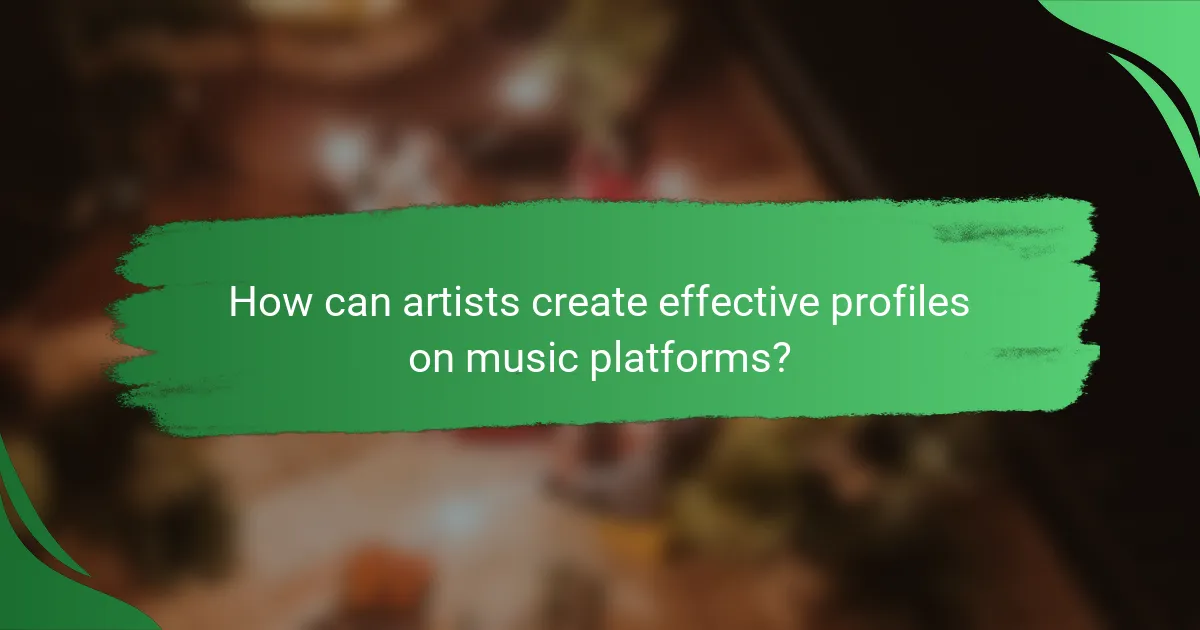
How can artists create effective profiles on music platforms?
Artists can create effective profiles on music platforms by showcasing their unique identity and engaging with their audience. A well-crafted profile not only highlights an artist’s music but also reflects their personality and brand, making it easier for fans to connect.
Profile optimization tips
To optimize a music profile, artists should focus on high-quality visuals and consistent branding. Use professional photos and a cohesive color scheme that aligns with your music style. Regularly update your profile with new releases, upcoming events, and relevant content to keep fans engaged.
Engagement is key; respond to comments and messages to build a community around your music. Utilize platform features like playlists or collaborations to increase visibility and attract new listeners.
Essential elements for artist profiles
Essential elements of an artist profile include a compelling bio, links to social media, and a selection of music samples. The bio should be concise yet informative, giving listeners insight into the artist’s journey and influences. Include links to popular social media platforms to facilitate easy fan interaction.
Music samples should showcase the artist’s best work, ideally including a mix of singles and collaborations. Consider adding a video or live performance clip to provide a more dynamic experience for visitors. Lastly, ensure that contact information is clear for booking inquiries and collaborations.
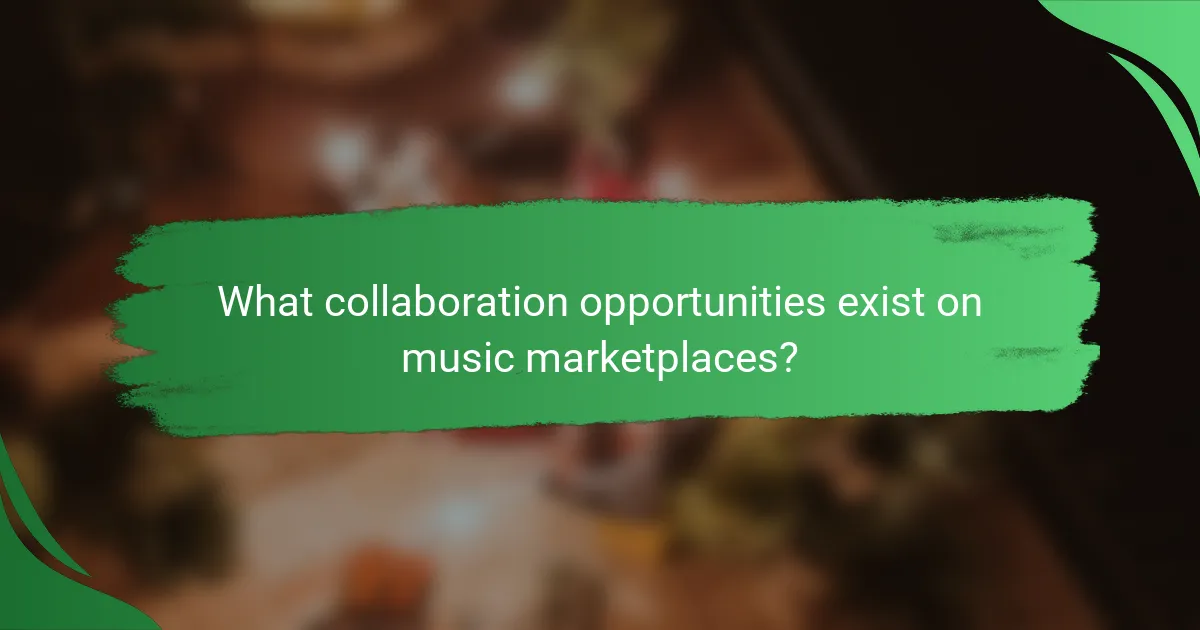
What collaboration opportunities exist on music marketplaces?
Music marketplaces offer various collaboration opportunities for artists, producers, and songwriters to connect and create together. These platforms facilitate networking, project sharing, and resource exchange, enabling users to find the right partners for their musical endeavors.
Finding collaborators on SoundBetter
SoundBetter is a popular platform for musicians seeking collaborators, including vocalists, producers, and mixing engineers. Users can create profiles showcasing their skills and previous work, making it easier to find suitable partners based on genre and expertise.
To find collaborators, browse through profiles, listen to samples, and read reviews from previous clients. It’s advisable to reach out with a clear project outline and expectations to ensure a good fit. Consider starting with small projects to build rapport before committing to larger collaborations.
Using Bandcamp for collaborations
Bandcamp primarily serves as a platform for artists to sell their music, but it also offers collaboration opportunities through its community features. Artists can connect with one another by following each other, sharing music, and participating in discussions.
To leverage Bandcamp for collaborations, engage with other artists by commenting on their releases or reaching out directly through messages. Collaborations can take the form of joint releases, remixes, or features on each other’s tracks. Keep in mind that building a network takes time, so be patient and consistent in your outreach efforts.
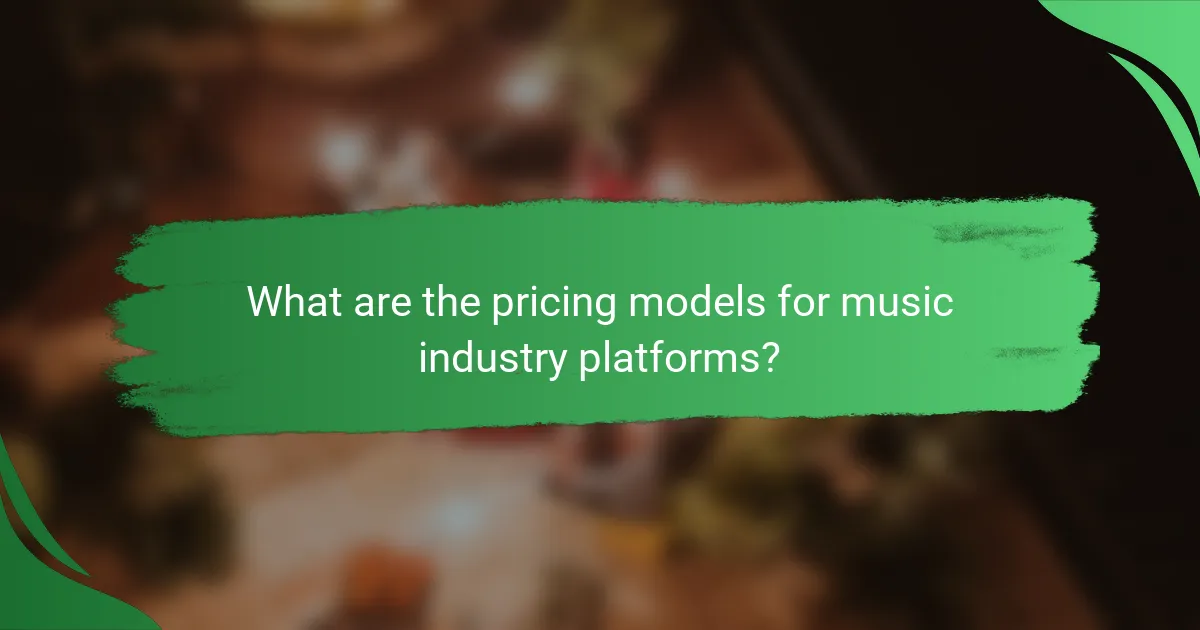
What are the pricing models for music industry platforms?
Music industry platforms typically utilize various pricing models, including subscription fees and commission structures. Understanding these models is crucial for artists and collaborators to effectively budget their expenses and maximize their earnings.
Subscription fees
Subscription fees are a common pricing model where users pay a recurring amount, often monthly or annually, to access platform features. This model can range from low single-digit USD amounts to higher tiers, depending on the services offered, such as premium tools for promotion or analytics.
Artists should evaluate what each subscription tier includes to ensure they are getting value for their investment. Some platforms may offer free trials or discounted rates for new users, which can be a good way to test the service before committing long-term.
Commission structures
Commission structures involve taking a percentage of sales or earnings generated through the platform. This model is prevalent in marketplaces where artists sell music, merchandise, or services, with commissions typically ranging from 5% to 20% of the transaction value.
When considering platforms with commission structures, artists should factor in how these fees impact their overall earnings. It’s essential to compare different platforms to find one with a fair commission rate that aligns with their sales goals. Additionally, be aware of any hidden fees that may apply to transactions or withdrawals.

How do music marketplaces support independent artists?
Music marketplaces provide independent artists with platforms to distribute their work, connect with fans, and collaborate with other musicians. These platforms enable artists to monetize their music through various revenue streams while offering tools for promotion and audience engagement.
Revenue generation methods
Independent artists can generate revenue through several methods on music marketplaces. Common options include digital sales, streaming royalties, merchandise sales, and crowdfunding. For instance, platforms like Bandcamp allow artists to sell their music directly to fans, often keeping a larger percentage of the profits compared to traditional labels.
Additionally, artists can earn income through licensing their music for use in films, commercials, or video games. This can be a lucrative avenue, especially if the music gains popularity in media. It’s essential for artists to explore multiple revenue streams to maximize their earnings.
Marketing tools available
Music marketplaces offer various marketing tools to help independent artists promote their work effectively. These tools often include social media integration, email marketing features, and analytics to track listener engagement. For example, platforms like SoundCloud provide artists with insights into their audience demographics and listening habits.
Moreover, many marketplaces facilitate collaboration with other artists, which can enhance visibility. By partnering with fellow musicians for joint projects or cross-promotions, independent artists can tap into new audiences. Utilizing these marketing tools strategically can significantly boost an artist’s reach and fanbase.
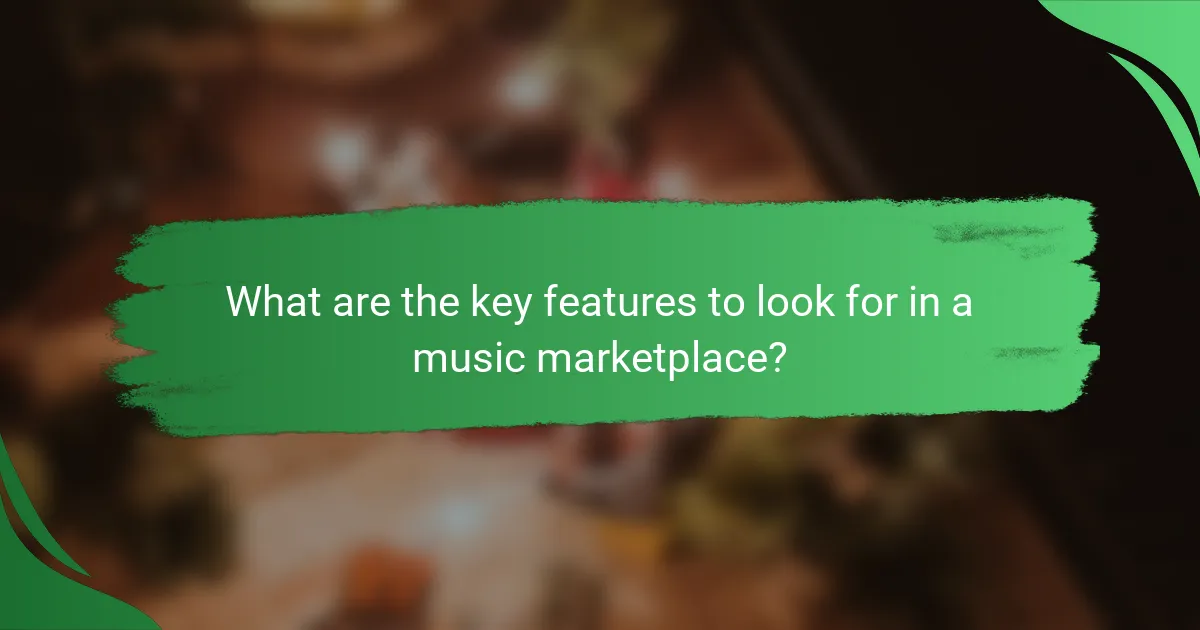
What are the key features to look for in a music marketplace?
When selecting a music marketplace, focus on features that enhance usability, promote collaboration, and foster community engagement. Key aspects include a user-friendly interface, effective communication tools, and options for artist promotion and networking.
User interface and experience
A well-designed user interface is essential for a positive experience in a music marketplace. Look for platforms that offer intuitive navigation, responsive design, and easy access to features such as profile creation, music uploads, and collaboration tools. A clean layout can significantly reduce the time it takes to find relevant resources or connect with other artists.
Consider platforms that provide customization options for artist profiles. Features like customizable banners, track previews, and social media integration can enhance visibility and allow artists to showcase their unique style effectively. The best marketplaces often include mobile-friendly designs, ensuring accessibility for users on various devices.
Community engagement options
Community engagement is crucial for building connections and fostering collaboration within a music marketplace. Look for platforms that offer features such as forums, chat rooms, or comment sections where artists and fans can interact. These tools facilitate discussions, feedback, and networking opportunities, which are vital for growth in the music industry.
Additionally, consider marketplaces that host events, contests, or collaborative projects. Such initiatives encourage participation and can lead to valuable partnerships. Platforms that allow users to follow each other and share content can also enhance community ties, making it easier for artists to promote their work and discover new talent.
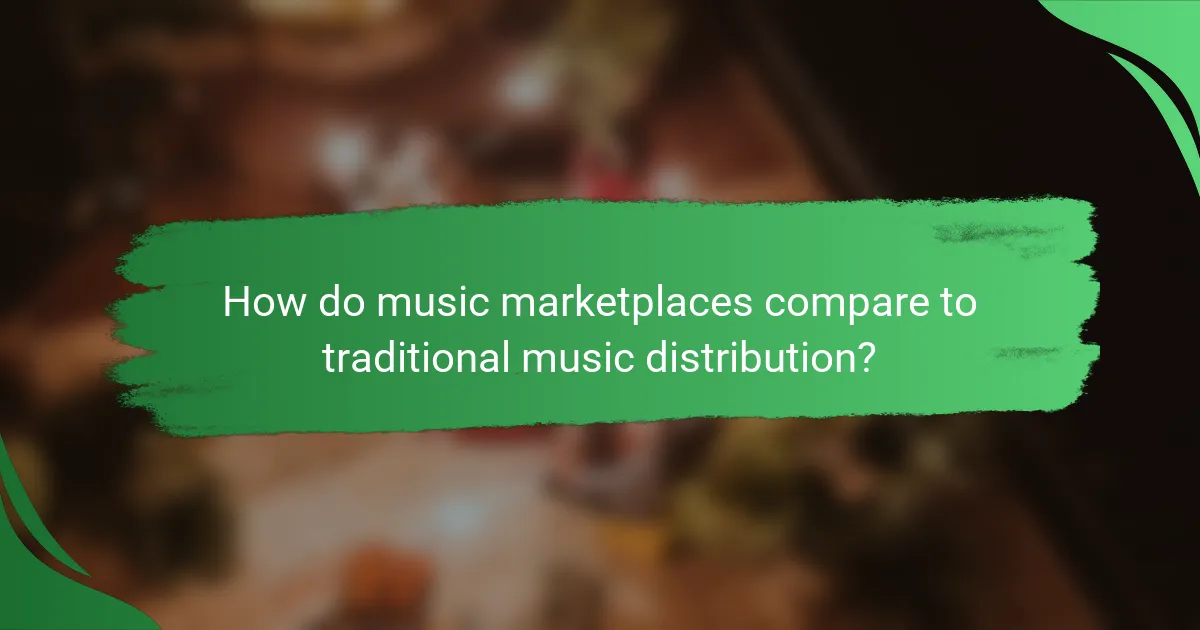
How do music marketplaces compare to traditional music distribution?
Music marketplaces offer a direct-to-artist model that contrasts with traditional distribution methods. While traditional distribution often involves record labels and intermediaries, music marketplaces enable artists to connect directly with fans and collaborators, streamlining the process of sharing and monetizing their work.
Benefits of Music Marketplaces
Music marketplaces provide several advantages over traditional distribution. Artists retain more control over their music, allowing them to set their own prices and terms. Additionally, these platforms often have lower fees compared to the high percentages taken by record labels, making it easier for artists to earn a fair income.
Another benefit is the ability to reach a global audience without the constraints of geographical boundaries. This accessibility can lead to increased exposure and opportunities for collaboration with other artists worldwide.
Challenges of Music Marketplaces
Despite their advantages, music marketplaces come with challenges. The competition can be fierce, as countless artists vie for attention on these platforms. This saturation may require artists to invest time and resources into marketing their profiles effectively.
Additionally, while artists have more control, they also bear the responsibility for managing their own distribution, promotion, and customer engagement. This can be overwhelming for those who prefer to focus solely on their creative work.
Key Considerations for Artists
When choosing between music marketplaces and traditional distribution, artists should consider their goals and resources. If they aim for independence and direct fan engagement, a marketplace may be the right choice. However, if they seek broader industry support and marketing, traditional routes might be more beneficial.
Artists should also evaluate the specific features of each marketplace, such as payment structures, audience demographics, and promotional tools. Understanding these factors can help them make informed decisions that align with their artistic vision and financial goals.
